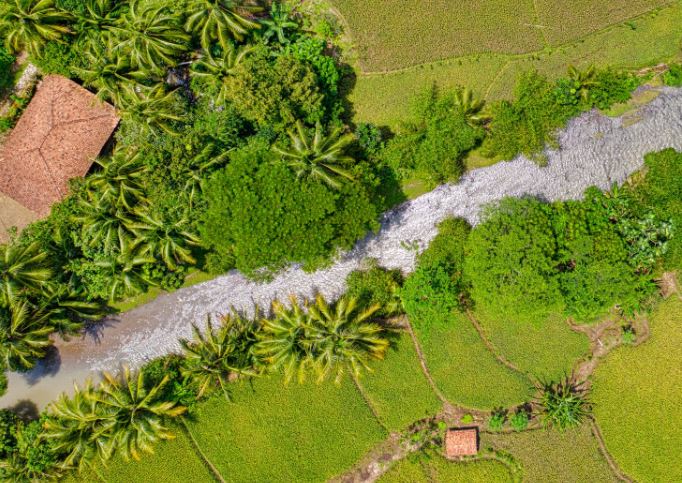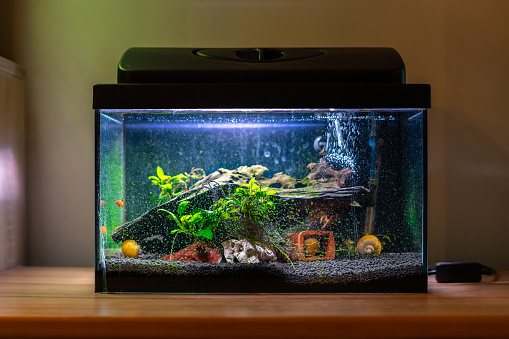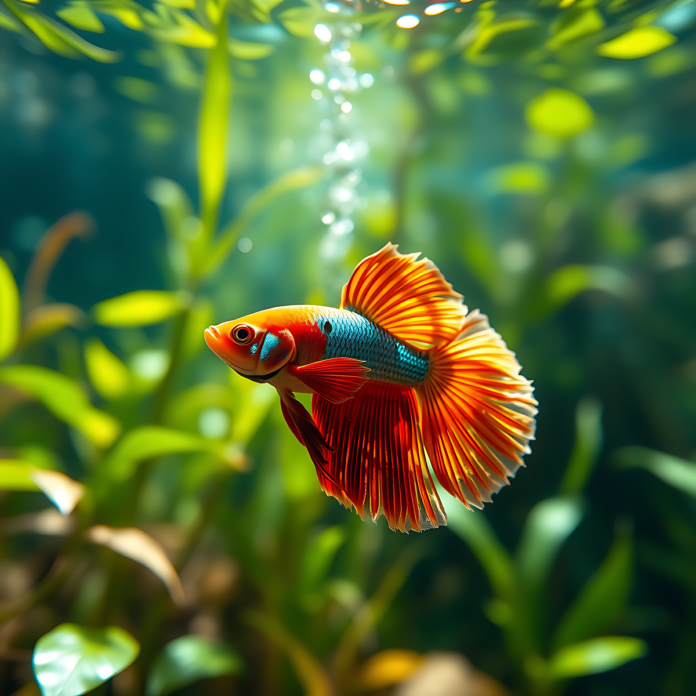Creating a Natural Betta Habitat: A Comprehensive Guide
Your Step-by-Step Guide to Designing the Perfect Natural Environment for Your Betta Fish

Betta fish, also known as Siamese fighting fish, are celebrated for their vibrant colors and graceful fins. Originating from the warm, shallow waters of Southeast Asia, they thrive in environments rich with plants and natural structures. Creating a natural Betta habitat in your aquarium not only enhances the aesthetic appeal but also promotes the health and well-being of your fish. This comprehensive guide will walk you through setting up the ideal natural habitat for your Betta.
Table of Contents
- Understanding the Natural Habitat of Betta Fish
- Choosing the Right Aquarium
- Selecting the Substrate
- Incorporating Live Plants
- Adding Natural Decorations
- Water Parameters and Filtration
- Lighting and Heating
- Introducing Your Betta to the Habitat
- Ongoing Maintenance Tips
- Conclusion
- FAQs
Understanding the Natural Habitat of Betta Fish
The Essence of a Natural Environment
In the wild, Betta fish inhabit:
- Shallow Rice Paddies and Slow-Moving Streams: These waters are warm, with plenty of hiding spots.
- Dense Vegetation: Provides shelter and breeding grounds.
- Soft, Slightly Acidic Water: Mimics the conditions of their native habitat.
By replicating these elements, you create a stress-free environment that encourages natural behaviors and vibrant coloration.
Choosing the Right Aquarium
Size Matters
- Minimum Tank Size: 5 gallons (19 liters) is recommended.
- Larger tanks offer more stable water conditions and space for enrichment.
- Tank Shape: A rectangular tank provides ample horizontal swimming space.
Benefits of a Larger Aquarium
- Stable Water Parameters: Reduces the risk of sudden changes in temperature and chemistry.
- Enhanced Well-Being: More space allows for natural exploration and activity.
Tip: Avoid small bowls or vases, which can be harmful to Betta health.
Selecting the Substrate
Natural Substrate Options
- Sand:
- Pros: Mimics riverbeds; ideal for bottom-dwelling plants.
- Cons: Can compact and cause anaerobic spots if not stirred.
- Gravel:
- Pros: Promotes beneficial bacteria growth; good for root systems.
- Cons: Debris can get trapped, requiring regular vacuuming.
Substrate Depth
- 2–3 Inches: Provides adequate depth for plant roots and beneficial bacteria colonization.
Visualization:
| Substrate Type | Benefits | Considerations |
|---|---|---|
| Sand | Natural look, soft | May compact over time |
| Gravel | Good for roots, aeration | Debris can get trapped |
Incorporating Live Plants
Benefits of Live Plants
- Improve Water Quality: Absorb nitrates and produce oxygen.
- Provide Shelter: Offer hiding places, reducing stress.
- Enhance Aesthetics: Create a lush, natural environment.
Ideal Plant Species for Betta Tanks
- Anubias Nana:
- Hardy and low-maintenance; attach to driftwood or rocks.
- Java Fern:
- Grows well in low light; doesn’t require substrate planting.
- Amazon Sword:
- Large leaves offer resting spots; needs nutrient-rich substrate.
- Water Wisteria:
- Fast-growing; can be planted or left floating.
- Marimo Moss Balls:
- Unique appearance; help absorb excess nutrients.
Plant Placement
- Background: Taller plants like Amazon Sword create depth.
- Midground: Medium-sized plants like Java Fern add fullness.
- Foreground: Short plants or moss for visual interest.
Tip: Ensure plants are aquarium-safe and free from pesticides.
Adding Natural Decorations
Driftwood and Rocks
- Driftwood:
- Releases beneficial tannins that slightly lower pH.
- Soak and rinse before adding to prevent excessive tannin release.
- Rocks:
- Use smooth, non-calcareous rocks to avoid altering water hardness.
Leaf Litter
- Indian Almond Leaves (Catappa Leaves):
- Promote natural healing; antibacterial and antifungal properties.
- Creates a tea-colored effect, simulating wild Betta habitats.
Creating Hiding Spots
- Caves and Ornaments:
- Provide shelter and reduce aggression.
- Floating Log:
- Offers a surface-level hiding spot.
Warning: Avoid decorations with sharp edges that could tear Betta fins.
Water Parameters and Filtration
Optimal Water Conditions
- Temperature: 76–82°F (24–28°C)
- pH Level: 6.0–7.5
- Water Hardness: Soft to moderately hard
Filtration
- Gentle Flow Filters:
- Sponge filters are ideal for minimal water movement.
- Adjustable Filters:
- Allow customization of flow rate to prevent stress.
Cycling the Tank
- Nitrogen Cycle:
- Establish beneficial bacteria to process waste.
- Testing:
- Regularly check ammonia, nitrite, nitrate, and pH levels.
Tip: Use water conditioners to remove chlorine and chloramines from tap water.
Lighting and Heating
Lighting Needs
- Natural Day-Night Cycle:
- 8–12 Hours of light per day.
- Light Intensity:
- Moderate lighting supports plant growth without promoting excessive algae.
Heating Essentials
- Consistent Temperature:
- Use an adjustable heater to maintain stable warmth.
- Thermometer:
- Monitor daily to prevent temperature fluctuations.
Visualization:

Introducing Your Betta to the Habitat
Acclimation Process
- Temperature Equalization:
- Float the Betta’s transport bag in the tank for 15–20 minutes.
- Gradual Mixing:
- Add small amounts of tank water to the bag every 5 minutes.
- Release:
- Gently net the Betta into the tank, avoiding transfer of bag water.
Observation
- Initial Behavior:
- Bettas may explore or hide initially; both are normal reactions.
- Feeding:
- Wait a few hours before offering food to reduce stress.
Ongoing Maintenance Tips
Regular Care
- Weekly Water Changes:
- Replace 25% of the water to maintain quality.
- Plant Care:
- Trim dead leaves; fertilize as needed with aquarium-safe products.
- Filter Maintenance:
- Rinse filter media in tank water during water changes.
Monitoring
- Behavioral Signs:
- Lethargy or loss of appetite may indicate issues.
- Water Testing:
- Keep a log to track any changes in parameters.
Tip: Consistency is key to a healthy Betta habitat.
Conclusion
Creating a natural Betta habitat is a fulfilling endeavor that enhances the life of your Betta fish. By closely mimicking their native environment with live plants, natural decorations, and optimal water conditions, you promote their health, vitality, and natural behaviors. Regular maintenance and attentive care will ensure your Betta thrives in its beautiful, naturalistic aquarium home.
FAQs
Q1: Can I use tap water for my Betta tank?
A: Yes, but always treat it with a water conditioner to neutralize chlorine, chloramines, and heavy metals.
Q2: How many live plants should I include in my Betta tank?
A: Incorporate a mix of foreground, midground, and background plants to provide ample coverage and aesthetic appeal.
Q3: Do I need a filter if I have live plants?
A: Yes, a filter helps maintain water quality by circulating water and housing beneficial bacteria, even in planted tanks.
Q4: What temperature should I maintain in the Betta tank?
A: Keep the water temperature between 76–82°F (24–28°C) for optimal health.
Q5: How often should I replace Indian Almond Leaves?
A: Replace every 3–4 weeks or when they start to disintegrate.
Transform your aquarium into a natural haven, and watch your Betta flourish like never before!
Explore More: Check out our other articles on Betta Fish Feeding Tips, Breeding Betta Fish, and Common Betta Health Issues to become a Betta expert.
Interested in sharing your natural Betta habitat setup? Leave a comment below or connect with us on social media!
Meta Description: Discover how to create a natural Betta habitat with our comprehensive guide. Learn about tank setup, live plants, decorations, and maintenance to ensure your Betta fish thrives.
Tips on replicating a betta’s natural environment in your home aquarium.
Disclaimer: This article is for informational purposes only. Always consult a professional aquarist or veterinarian for specific advice regarding your Betta fish.


